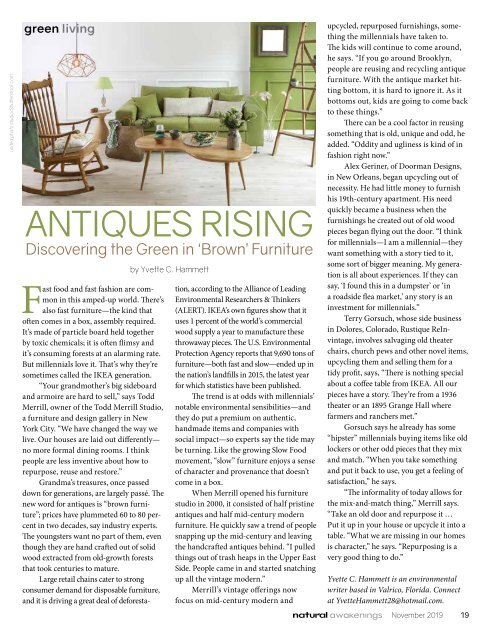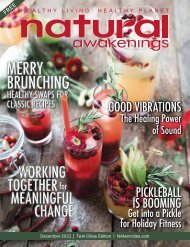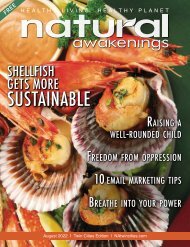Natural Awakenings Twin Cities November 2019
Natural Awakenings Twin Cities magazine is your source for healthy living, healthy planet information. Have you visited our website lately? Sign up for our Newsletter and Digital Magazine, read archived articles from local experts, and keep up with local healthy living events. Visit NATwinCities.com today. We provide a complete toolkit for businesses. List your healthy or green business for free. Enter your calendar events for free.
Natural Awakenings Twin Cities magazine is your source for healthy living, healthy planet information. Have you visited our website lately? Sign up for our Newsletter and Digital Magazine, read archived articles from local experts, and keep up with local healthy living events. Visit NATwinCities.com today.
We provide a complete toolkit for businesses. List your healthy or green business for free. Enter your calendar events for free.
You also want an ePaper? Increase the reach of your titles
YUMPU automatically turns print PDFs into web optimized ePapers that Google loves.
united photo studio/Shutterstock.com<br />
green living<br />
ANTIQUES RISING<br />
Discovering the Green in ‘Brown’ Furniture<br />
by Yvette C. Hammett<br />
Fast food and fast fashion are common<br />
in this amped-up world. There’s<br />
also fast furniture—the kind that<br />
often comes in a box, assembly required.<br />
It’s made of particle board held together<br />
by toxic chemicals; it is often flimsy and<br />
it’s consuming forests at an alarming rate.<br />
But millennials love it. That’s why they’re<br />
sometimes called the IKEA generation.<br />
“Your grandmother’s big sideboard<br />
and armoire are hard to sell,” says Todd<br />
Merrill, owner of the Todd Merrill Studio,<br />
a furniture and design gallery in New<br />
York City. “We have changed the way we<br />
live. Our houses are laid out differently—<br />
no more formal dining rooms. I think<br />
people are less inventive about how to<br />
repurpose, reuse and restore.”<br />
Grandma’s treasures, once passed<br />
down for generations, are largely passé. The<br />
new word for antiques is “brown furniture”;<br />
prices have plummeted 60 to 80 percent<br />
in two decades, say industry experts.<br />
The youngsters want no part of them, even<br />
though they are hand crafted out of solid<br />
wood extracted from old-growth forests<br />
that took centuries to mature.<br />
Large retail chains cater to strong<br />
consumer demand for disposable furniture,<br />
and it is driving a great deal of deforestation,<br />
according to the Alliance of Leading<br />
Environmental Researchers & Thinkers<br />
(ALERT). IKEA’s own figures show that it<br />
uses 1 percent of the world’s commercial<br />
wood supply a year to manufacture these<br />
throwaway pieces. The U.S. Environmental<br />
Protection Agency reports that 9,690 tons of<br />
furniture—both fast and slow—ended up in<br />
the nation’s landfills in 2015, the latest year<br />
for which statistics have been published.<br />
The trend is at odds with millennials’<br />
notable environmental sensibilities—and<br />
they do put a premium on authentic,<br />
handmade items and companies with<br />
social impact—so experts say the tide may<br />
be turning. Like the growing Slow Food<br />
movement, “slow” furniture enjoys a sense<br />
of character and provenance that doesn’t<br />
come in a box.<br />
When Merrill opened his furniture<br />
studio in 2000, it consisted of half pristine<br />
antiques and half mid-century modern<br />
furniture. He quickly saw a trend of people<br />
snapping up the mid-century and leaving<br />
the handcrafted antiques behind. “I pulled<br />
things out of trash heaps in the Upper East<br />
Side. People came in and started snatching<br />
up all the vintage modern.”<br />
Merrill’s vintage offerings now<br />
focus on mid-century modern and<br />
upcycled, repurposed furnishings, something<br />
the millennials have taken to.<br />
The kids will continue to come around,<br />
he says. “If you go around Brooklyn,<br />
people are reusing and recycling antique<br />
furniture. With the antique market hitting<br />
bottom, it is hard to ignore it. As it<br />
bottoms out, kids are going to come back<br />
to these things.”<br />
There can be a cool factor in reusing<br />
something that is old, unique and odd, he<br />
added. “Oddity and ugliness is kind of in<br />
fashion right now.”<br />
Alex Geriner, of Doorman Designs,<br />
in New Orleans, began upcycling out of<br />
necessity. He had little money to furnish<br />
his 19th-century apartment. His need<br />
quickly became a business when the<br />
furnishings he created out of old wood<br />
pieces began flying out the door. “I think<br />
for millennials—I am a millennial—they<br />
want something with a story tied to it,<br />
some sort of bigger meaning. My generation<br />
is all about experiences. If they can<br />
say, ‘I found this in a dumpster’ or ‘in<br />
a roadside flea market,’ any story is an<br />
investment for millennials.”<br />
Terry Gorsuch, whose side business<br />
in Dolores, Colorado, Rustique ReInvintage,<br />
involves salvaging old theater<br />
chairs, church pews and other novel items,<br />
upcycling them and selling them for a<br />
tidy profit, says, “There is nothing special<br />
about a coffee table from IKEA. All our<br />
pieces have a story. They’re from a 1936<br />
theater or an 1895 Grange Hall where<br />
farmers and ranchers met.”<br />
Gorsuch says he already has some<br />
“hipster” millennials buying items like old<br />
lockers or other odd pieces that they mix<br />
and match. “When you take something<br />
and put it back to use, you get a feeling of<br />
satisfaction,” he says.<br />
“The informality of today allows for<br />
the mix-and-match thing,” Merrill says.<br />
“Take an old door and repurpose it …<br />
Put it up in your house or upcycle it into a<br />
table. “What we are missing in our homes<br />
is character,” he says. “Repurposing is a<br />
very good thing to do.”<br />
Yvette C. Hammett is an environmental<br />
writer based in Valrico, Florida. Connect<br />
at YvetteHammett28@hotmail.com.<br />
<strong>November</strong> <strong>2019</strong><br />
19

















